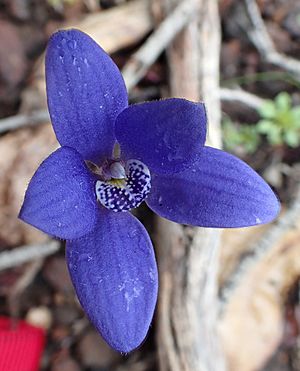Blue china orchid facts for kids
Quick facts for kids Blue china orchid |
|
|---|---|
 |
|
| Caladenia gemmata growing in a Perth suburb | |
| Scientific classification | |
| Genus: |
Caladenia
|
| Species: |
gemmata
|
| Synonyms | |
|
|
The blue china orchid (scientific name: Caladenia gemmata) is a beautiful flower. It belongs to the orchid family. This special plant grows only in the south-west part of Western Australia. It has a small, oval-shaped leaf. You can see up to three bright blue or purplish flowers on one plant. This orchid is the most common type of china orchid in Western Australia. Sometimes, many of them appear after summer fires.
Contents
What Does the Blue China Orchid Look Like?
The blue china orchid is a plant that grows from an underground tuber. This means it has a special root that stores food. It's a perennial plant, so it lives for more than two years. It's also deciduous, meaning it sheds its leaves. The plant has one dark green, shiny leaf. This leaf is about 20–40 mm (0.8–2 in) long and 10–20 mm (0.4–0.8 in) wide. It has a purplish color underneath.
Flower Features
The blue china orchid produces up to three flowers. These flowers are a bright blue to purplish color. Each flower is about 20–50 mm (0.8–2 in) long and wide. They grow on a stalk that is 40–150 mm (2–6 in) tall. The top part of the flower, called the dorsal sepal, stands straight up. It is about 20–30 mm (0.8–1 in) long and 5–10 mm (0.2–0.4 in) wide. The side sepals and petals are similar in size.
The Labellum
The labellum is a special lip-like part of the orchid flower. For the blue china orchid, it is about 5–8 mm (0.2–0.3 in) long and 5–7 mm (0.2–0.3 in) wide. It is purple and blue. The tip of the labellum curves downwards. This part of the flower has many small, round, bead-like bumps. These bumps are called calli. The blue china orchid usually blooms from August to early November.
How the Blue China Orchid Got Its Name
The blue china orchid was first officially described in 1840. A scientist named John Lindley wrote about it. His description was published in a book called A Sketch of the Vegetation of the Swan River Colony.
Changes to the Name
Over the years, the scientific name of this orchid changed a few times. In 2000, scientists Stephen Hopper and Andrew Brown changed its name to Cyanicula gemmata. But later, in 2015, another scientist named Mark Clements changed it back. He used new studies of plant genetics to make this decision. The name became Caladenia fragrans for a short time, but the original name Caladenia gemmata is now used.
Meaning of the Name
The second part of its scientific name, gemmata, is a Latin word. It means "with buds, eyes, or jewels." This name refers to the small, bead-like calli on the labellum. They look like tiny jewels!
Where Does the Blue China Orchid Live?
The blue china orchid is a very common and widespread plant. You can find it across a large area of Western Australia. It grows from Kalbarri in the north all the way to Israelite Bay in the east.
Its Favorite Places
This orchid can live in many different types of places. It grows in open, shrubby areas called heathland. It also thrives in forests. Plants that grow in wetter areas often flower more after summer fires. This shows how tough and adaptable this beautiful orchid is.
Is the Blue China Orchid Endangered?
No, the blue china orchid is not in danger. The Western Australian Government's Department of Parks and Wildlife has classified it as "not threatened." This means there are plenty of these orchids around.

